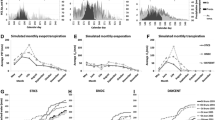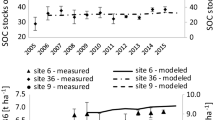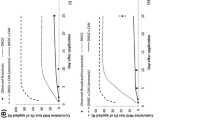Abstract
Modelling nitrogen (N) dynamics in agricultural soils can improve our understanding of the nitrogen cycle in rotational systems. NDICEA (Nitrogen Dynamics in Crop rotations in Ecological Agriculture) is a tool to model soil N dynamics for maximum nitrogen use efficiency (NUE) and minimum environmental impacts from agricultural fertilization. In this study the model was calibrated using actual soil mineral N data from 2 years of a long-term organic versus conventional systems comparison trial. Calibration data was used from only the organic crop protection treatments for an organic crop rotation under (a) organic fertility management (ORG-OF) and (b) conventional fertility management (ORG-CF), and a conventional crop rotation under (c) organic fertility management (CON-OF), and (d) conventional fertility management (CON-CF). The model was subsequently validated using the same four treatment combinations from the conventional crop protection treatments. The accuracy of soil mineral N predictions was consistently improved after calibration, with the model performing best under organic fertilization regimes; reflecting the model’s original purpose. The lack of difference among treatments for the calibrated soil parameters demonstrated that the calibration procedure was robust and could result in a model that is superior to the non-calibrated one, and specific for this soil type, regardless of soil management practices. The simplification of complex biological processes into model parameters limits the use of NDICEA as a tool to explain the underlying processes driving soil N dynamics. Nevertheless it could be a useful tool for visualising field-scale N dynamics, allowing farmers and advisors to explore the impact of changing management factors on within-field N efficiency.



Similar content being viewed by others
References
Abrahamsen P, Hansen S (2000) Daisy: an open soil-crop-atmosphere system model. Environ Model Software 15:313–330
Avery BW (1980) Soil classification for England and Wales. Harpenden, UK
Berntsen J, Grant R, Olesen JE, Kristensen IS, Vinther FP, Mølgaard JP, Petersen BM (2006) Nitrogen cycling in organic farming systems with rotational grass–clover and arable crops. Soil Use Manage 22:197–208. doi:10.1111/j.1475-2743.2005.00016.x
Bilsborrow PE, Cooper JM, Tétard-Jones C et al (2013) The effect of organic and conventional management on the yield and quality of wheat grown in a long-term field trial. Eur J Agron 51:71–80
Bradbury N, Whitmore A, Hart P, Jenkinson D (1993) Modelling the fate of nitrogen in crop and soil in the years following application of 15N-labelled fertilizer to winter wheat. J Agric Sci 121:363–379
Burgos P, Madejon E, Cabrera F (2006) Nitrogen mineralization and nitrate leaching of a sandy soil amended with different organic wastes. Waste Manage Res 24:175–182. doi:10.1177/0734242x06062876
Cooper J, Sanderson R, Cakmak I et al (2011) Effect of Organic and Conventional Crop Rotation, Fertilization, and Crop Protection Practices on Metal Contents in Wheat (Triticum aestivum). J Agric Food Chem 59:4715–4724
Cooper JM, Carmichael A, Stockdale EA, Quemada M, Thorup Kristensen K, Van der Burgt GJHM, Scholberg JM (2009) Inventory of existing decision support tools for farm level N management in the EU. Newcastle University, Newcastle Upon Tyne, UK
Diez JA, Tarquis A, Cartagena MC, Vallejo A (2006) Optimisation of N application for a maize crop grown in a shallow, irrigated soil. Spanish Journal of Agricultural Research 4:373–380
do Nascimento AF, de Sá Mendonça E, Leite LFC, Scholberg J, Neves JCL (2012) Calibration and validation of models for short-term decomposition and N mineralization of plant residues in the tropics. Scientia Agricola 69:393–401
Franko U, Oelschlägel B, Schenk S (1995) Simulation of temperature-, water- and nitrogen dynamics using the model CANDY. Ecol Model 81:213–222
Gabrielle B, Mary B, Roche R, Smith P, Gosse G (2002) Simulation of carbon and nitrogen dynamics in arable soils: a comparison of approaches. Eur J Agron 18:107–120. doi:10.1016/S1161-0301(02)00099-0
Ghorbani R, Wilcockson S, Koocheki A, Leifert C (2010) Soil Management for Sustainable Crop Disease Control: A Review. In: Lichtfouse E (ed) Organic Farming, Pest Control and Remediation of Soil Pollutants, vol 1, Sustainable Agriculture Reviews. Springer, The Netherlands, pp 177–201
Glendining MJ, Smith JU (1999) Using a rotational modelling system to explore the effect of straw incorporation on the efficiency of nitrogen use. In: Wilson WS, Ball AS, Hinton RH (eds) Managing Risks of Nitrates to Humans and the Environment. Royal Society of Chemistry, Cambridge, UK, pp 58–64
Graves A, Hess T, Matthews R (2002) Ch. 12 Using Models as Tools in Education and Training. In: Matthews R, Stephens W (eds) Crop-soil Simulation Models: Applications in Developing Countries. CABI Pub., Wallingford, Oxon, UK, pp 152–182
Han G-Z, Zhang G-L, Gong Z-T, Wang G-F (2012) Pedotransfer Functions for Estimating Soil Bulk Density in China Soil Sci 177:158–164. doi:10.1097/SS.0b013e31823fd493
Hepperly P, Lotter D, Ulsh C, Seidel R, Reider C (2009) Compost, manure and synthetic fertilizer influences crop yields, soil properties, nitrate leaching and crop nutrient content. Compost Sci Util 17:117
Herencia JF, Ruiz-Porras JC, Melero S, Garcia-Galavis PA, Morillo E, Maqueda C (2007) Comparison between organic and mineral fertilization for soil fertility levels, crop macronutrient concentrations, and yield. Agron J 99:973–983
Hoitink H, Stone A, Han D (1997) Suppression of plant diseases by composts Hort Science 32:184–187
Jones JW, Hoogenboom G, Porter CH et al (2003) The DSSAT cropping system model. Eur J Agron 18:235–265
Keeney DR, Nelson DW (1982) Nitrogen - inorganic forms. In: Page AL, Miller RH, Keeney DR (eds) Methods of soil analysis Part 2 Chemical and microbiological properties, 2nd edn. American Society of Agronomy, Madison, WI, pp 643–698
Kersebaum K, Hecker J-M, Mirschel W, Wegehenkel M (2007) Modelling water and nutrient dynamics in soil–crop systems: a comparison of simulation models applied on common data sets. In: KCKe (ed) Modelling Water and Nutrient Dynamics in Soil–Crop Systems. pp 1–17
Koopmans CJ, Bokhorst J (2002) Nitrogen mineralization in organic farming systems: a test of the NDICEA model. Agronomie 22:855–862
Lammerts van Bueren E, Jones SS, Tamm L, Murphy KM, Myers JR, Leifert C, Messmer M (2010) The need to breed crop varieties suitable for organic farming, using wheat, tomato and broccoli as examples: A review NJAS. Wageningen Journal of Life Sciences 58:193–205
Li C, Frolking S, Frolking T (1992) A model of nitrous oxide evolution from soil driven by rainfall events: 1. Model structure and sensitivity Journal of Geophysical Research: Atmospheres 97:9759–9776
Loague K, Green R (1991) Statistical and graphical methods for evaluating solute transport models: Overview and application. J Contam Hydrol 7:51–73
Norman R, Kurtz L, Stevenson F (1987) Distribution and recovery of nitrogen-15-labeled liquid anhydrous ammonia among various soil fractions. Soil Sci Soc Am J 51:235–241
Palmer MW, Cooper J, Tétard-Jones C et al (2013) The influence of organic and conventional fertilisation and crop protection practices, preceding crop, harvest year and weather conditions on yield and quality of potato (Solanum tuberosum) in a long-term management trial. Eur J Agron 49:83–92
R Development Core Team (2011) R: A language and environment for statistical computing. R Foundation for Statistical Computing. http://www.R-project.org.
Rahn CR, Zhang K, Lillywhite R et al (2007) BRIEF DESCRIPTION OF THE EU-ROTATE_N MODEL 8/08/2007. Horticulture Research International, Warwick, UK
Rahn CR, Zhang K, Lillywhite R et al (2010) EU-Rotate_N – a Decision Support System – to Predict Environmental and Economic Consequences of the Management of Nitrogen Fertiliser in Crop Rotations. European Journal of Horticultural Science 75:20–32
Rayns F, Rosenfeld A, Schmutz U (2009) Rahn C. A comparison of two models to predict nitrogen dynamic in organic agricultural systems Aspects of Applied Biology 93:219–222
Red Tractor Farm Assurance (2010) Crops and Sugarbeet Standards. London, U.K.
Refsgaard J (1997) Parameterisation, calibration and validation of distributed hydrological models. Journal of Hydrology 198:69–97
Sassenrath GF, Schneider JM, R.Gaj, Grzebisz W, Halloran JM (2012) Nitrogen balance as an indicator of environmental impact: Toward sustainable agricultural production Renew Agric Food Syst:1–12 doi:doi:10.1017/S1742170512000166
Smith JU, Glendining MJ, Smith P (1996) SUNDIAL: A PC-based version of the Rothamsted nitrogen turnover model. Agron J 88:38–42
Smith P, Smith JU, Powlson DS et al (1997) A comparison of the performance of nine soil organic matter models using datasets from seven long-term experiments. Geoderma 81:153–225
Soil Association (2012) Soil Association organic standards farming and growing.
Swain E, Rempelos L, Orr CH et al (2014) Optimizing nitrogen use efficiency in wheat and potatoes: interactions between genotypes and agronomic practices. Euphytica 199:119–136
van der Burgt G (2008) The NDICEA model: a practical instrument to improve nitrogen efficiency. Paper presented at the QLIF Seminar. Driebergen, The Netherlands
van der Burgt G, Oomen G, Rossing W (2006a) The NDICEA model as a learning tool: field experiences 2005
van der Burgt GJHM, Oomen GJM, Habets ASJ, Rossing WAH (2006b) The NDICEA model, a tool to improve nitrogen use efficiency in cropping systems. Nutr Cycl Agroecosys 74:275–294
van der Burgt GJHM, Top CFE, Watson CA, Oomen GJM (2006c) Rossing WAH. Predicting soil nitrogen dynamics for an organic rotation using NDICEA Aspects of Applied Biology 80:217–223
Acknowledgements
The authors wish to thank Gavin Hall and Rachel Chapman (both from Newcastle University, UK) for providing the soil and crop samples which were collected as part of the Integrated Project NUE-CROPS EU-FP7 222–645, funded by the European Community under the Seventh Framework Programme for Research, Technological Development and Demonstration Activities. Thanks to Geert Jan van der Burgt for guidance and advice on NDICEA use over many years.
Author information
Authors and Affiliations
Corresponding author
Rights and permissions
About this article
Cite this article
Swain, E.Y., Almadni, M., Leifert, C. et al. NDICEA Calibration and validation on a northern UK soil. Org. Agr. 6, 267–280 (2016). https://doi.org/10.1007/s13165-015-0134-2
Received:
Accepted:
Published:
Issue Date:
DOI: https://doi.org/10.1007/s13165-015-0134-2




